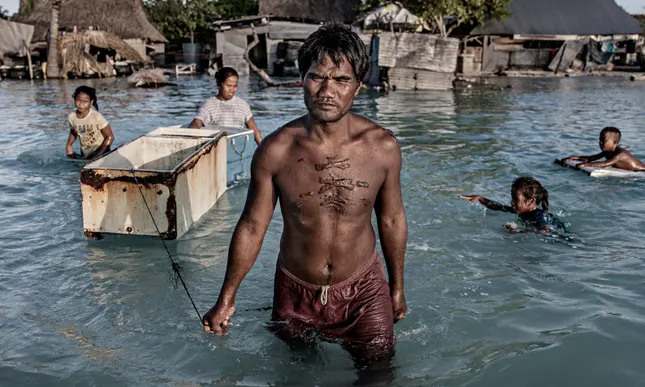As the climate crisis forces migration, so native tongues wither, too. But it’s not too late to intervene
By Anastasia Riehl
Rising sea levels already pose an existential threat to the populations of Tuvalu, Kiribati, the Marshall Islands and other low-lying Pacific atolls. In these places, however, it is not just homes, crops and community cohesiveness that are at risk: it is Tuvaluan, Kiribati and Marshallese – the languages native to these islands.
The impact of the climate crisis on languages may be new, but the relationship between language and climate is old. As humans populated the Earth, climate and geography were enormous factors in where they settled and flourished. The equatorial region, with its consistent temperatures, predictable rainfall and abundant agricultural opportunities, was particularly agreeable.
Humans thrived in these areas – inhabiting a valley here, an islet there – giving rise to thousands of different communities, and with them thousands of different languages. Today, vastly more of the world’s languages are spoken in the tropics than at higher latitudes.
It is not just humans and languages that have prospered in nurturing climates but species of all kinds. Research on biocultural diversity finds striking parallels between the evolution of species and languages. Where a new species rooted and blossomed, so did a language. Of the roughly 7,000 languages spoken today, 70 percent are concentrated in only 25 percent of the Earth’s land area – precisely in those areas with the highest biodiversity. Unfortunately, this shared fate binds them in birth as well as death, with both species and languages facing extinction crises.
If the story of climate and language has long been one of harmony, the climate crisis is the plot twist. In a tragic reversal, it is precisely those areas of the Earth that were the most hospitable to people and languages, to species of all kinds, that are now becoming the least hospitable. The climate called us in, and now the climate is casting us out.
But how can the climate hurt a language? The sea will not suddenly swallow an entire linguistic community in one gulp, dying words left bobbing upon the waves. The speakers will leave their islands before that happens. In fact, a changing climate, whether through rising seas, drought or catastrophic storms, will probably never be the sole culprit in a language’s death.
Rather, the threat of the climate emergency is the threat of forced migration. As a population is compelled to abandon its lands and move into a new community – a neighbouring village, a refugee camp, an urban centre – its Indigenous language becomes harder to sustain.
To make matters worse, a crisis of language loss was well under way even before global temperatures began to rise. More than half of the world’s languages are already considered endangered, with the most pessimistic estimates putting the figure at 90 percent.
There are many contributors to this dire statistic – the imposition of national languages; government persecution of linguistic minorities; the ascendance of international languages in the era of globalisation; and a lack of media and resources for education in minority languages.
Languages do not expire suddenly, they wither gradually. As a community begins to adopt different languages for use in different contexts, intergenerational transmission of their Indigenous language may decrease, until ultimately it is no longer spoken at all. The climate crisis, which will greatly exacerbate the threats to languages, is poised to be a leading accelerant of such loss.
On a precarious planet, should languages be a major concern? While access to food, water, shelter and safety may be the most immediate human needs, linguistic diversity is far from trivial. Languages are intricately woven into culture and identity. They encode histories, they catalogue plants and perspectives, they define peoples.
Languages are vast databases of information. If they die, this information is lost to science. So, too, is our opportunity to learn more about ourselves.
But this story is not over. The gradual nature of language loss affords an opportunity to intervene and to redirect the narrative. Already, Indigenous communities and linguists are working together to document hundreds of languages, and revitalisation efforts are breathing new life into languages that were once on the decline. Even tiny Tuvaluan, as it migrates from its islands, finds hope in New Zealand, where the expatriate community prioritises the teaching of language and culture to the youth.
Last December, Unesco launched the Indigenous Languages Decade to draw attention to the crisis of our languages and to mobilise resources to confront it. Awareness of the threats to languages is growing; concern over the climate emergency is also increasing. Perhaps by linking these two existential threats, our efforts to address one problem will help to alleviate the other.
The climate crisis is a force of destruction but can also be a force of unification. If languages and species live and die together, surely we can save them together.
SOURCE: THE GUARDIAN/PACNEWS















